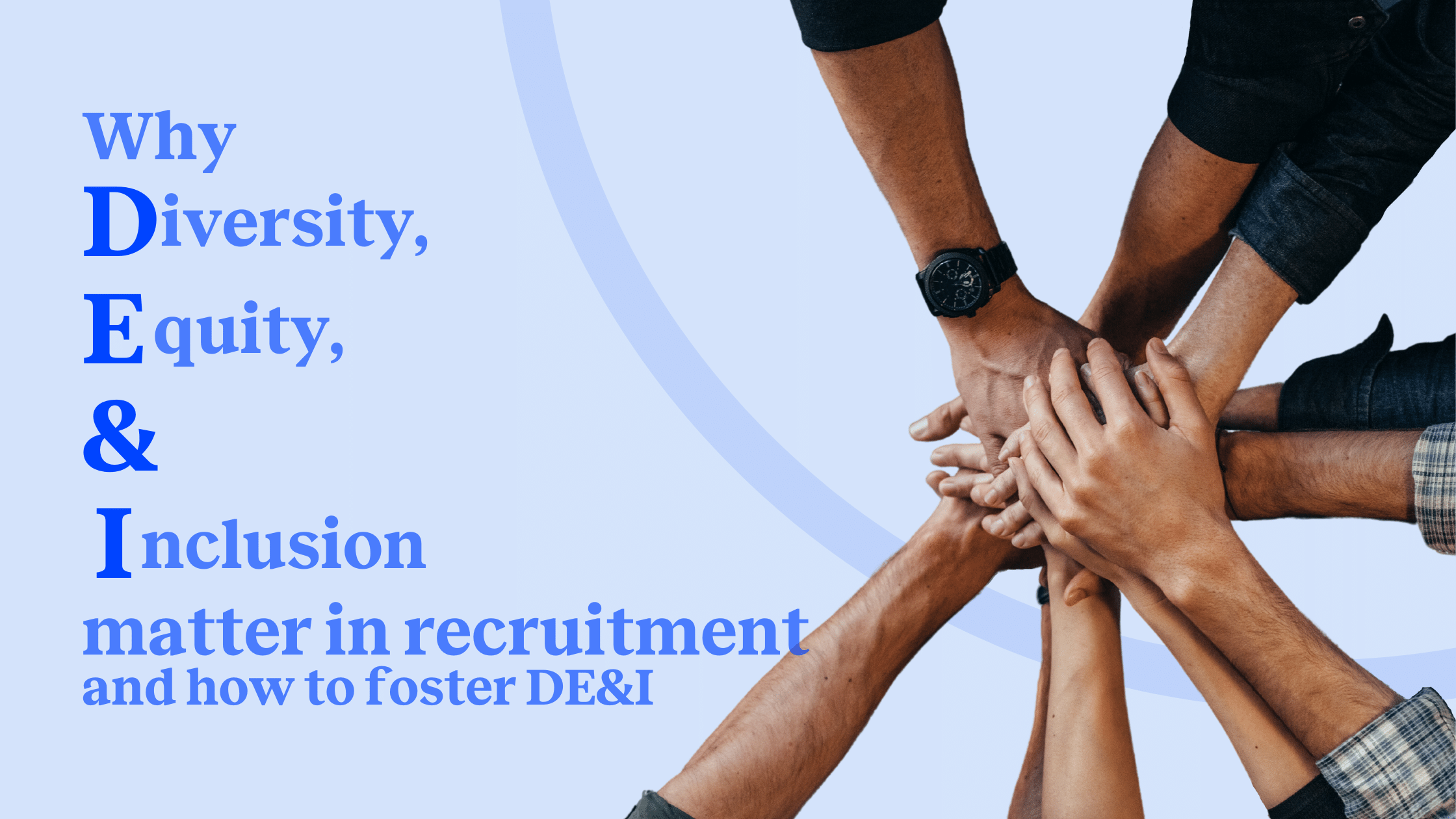
Jan Söderström

The best workplaces are inclusive ones. To take real action on diversity, equity, and inclusion (DE&I) in the workplace, it can’t just be an afterthought. Instead, DE&I should be actively sought out during the recruitment process. You need to intentionally create an inclusive interview process and hire from underrepresented groups.
Of course, DE&I is not an HR-only task—it should be implemented company-wide and embedded into every company function. However, the HR and recruitment department often initiates change towards making the organization more diverse, inclusive, and equitable.
In this post, we’ll go over the basics of DE&I, and share tips for how to recruit for diversity, equity, and inclusion.
Diversity, equity, and inclusion in the workplace refers to policies and programs that promote the representation of different groups of individuals that may include race, socioeconomic status, ethnicity, religion, nationality, (dis)ability, language, gender, sexual orientation, age, or political perspective. It’s about dismantling systems that oppress people at work and building equitable workplaces.
Talent Lead at Zinc Work, Sophie Power, shares how she sees it: “DE&I is a commitment to valuing diversity, creating an inclusive environment, and serving all individuals with empathy and respect. DE&I must be woven into the fabric of an organization in order to create lasting change. This starts with HR managers building an inclusive interview experience and overall hiring strategy.”
To break down this term, let’s consider each word individually in the context of the workplace:
Diverse, inclusive, and equitable teams create better companies and happier individuals. We all intuitively know DE&I to be important, and it also makes sense in purely business terms: Companies in the top quartile for racial and ethnic diversity are 35% more likely to have financial returns above their national industry medians, and those in the top quartile for gender diversity are 15% more likely, according to McKinsey research.
There are four areas in which DE&I has significant impact, according to Catalyst research:
1) talent
2) innovation & performance
3) reputation & responsibility
4) financial performance
Focusing on talent: Diverse organizations are more successful at recruiting and retaining talent. For example, women are more likely to express interest in an organization where women are highly represented in top management positions, according to the same Catalyst report.
Employees in more inclusive organizations are also 45% more likely to stay at their organization and 90 percent more likely to go out of their way to help a colleague, according to a McKinsey study.
We all have unconscious biases—assumptions our brains make without us being aware of them. When we let our unconscious biases take over, we risk recruiting people ‘just like us’ so we need to work to counter this and avoid letting our biases influence our decisions.
Common biases in hiring include:
To help overcome unconscious biases, everyone on the hiring team should understand what skills, qualities, and experience are needed for the role being recruited for so that everyone can focus on picking the best candidate.
To hire a more diverse team and promote inclusivity, you need to be aware of the systems of oppression that impact people from historically marginalized communities.
Job seekers are demanding more from employers today, and you need to be able to show that the organization takes DE&I seriously. And that starts with a fair and inclusive recruitment process.
Targeted trainings can help recruiters and hiring managers to mitigate privilege, bias, and power dynamics in the hiring process. Leaders at different levels—including senior leaders, managers, and team leads—should also be trained on how to embed DE&I in day-to-day work across the organization.
Training and education sessions could focus on biases, micro-inequities, microaggressions, systemic racism and inequities, stereotypes, inclusive language, privilege, effective ally-ship, self-advocacy, and more. The training should be focused on your specific context, and include action-oriented ways to hire fairly.
The right messaging in your job postings can provide a more inclusive environment for job seekers and attract candidates from underrepresented groups.
When crafting job postings, be aware of the language used and avoid excluding anyone. For example, while you might be looking to hire someone who’s fluent in English, that doesn’t mean they need to be a native speaker. Instead of writing “native English speaker” as a requirement, you can instead write “fluency in English” is required.
Paying special attention to language is particularly important when writing or translating job ads into other languages. Avoid using gendered pronouns, terms, and titles in job descriptions to ensure you don’t dissuade candidates based on their gender.
Before publishing anything, review all recruitment documentation for inclusive language, and ask a colleague for a second look. Consider using a tool like Diversifier, which flags non-inclusive words and phrases, to create job ads that are appealing to people with diverse backgrounds.
If you aren’t attracting sufficiently diverse applicants with your current channels, research and use new channels and boards to find candidates that might not be well known to you.
For example, check into government schemes or training and mentorship programs that fast track less experienced hires.
To create a fair hiring process, make sure all candidates go through the same process, from the interview questions to any assignments given. Standardized interview questions ensure no candidates get special treatment.
Jonathan Laitala, HR Business Partner, JYSK, explains the benefits of standardizing the interview process with pre-recorded video interview: “The biggest benefit of standardizing the process is transparency. Before when managers did phone interviews themselves, we didn’t have any track records of what they discussed and how they decided to invite a specific person to an interview. Now we have all the answers in the videos.”
When multiple people from the hiring team can watch candidates’ video replies, challenge each other’s decisions, and reflect together, you’re able to reduce bias and ensure fair hiring decisions.
All individuals—regardless of race, ethnicity, gender, sexual orientation, or disability—should feel comfortable and respected in the workplace
To create a climate of respect and understanding, make sure all recruitment materials are designed with diversity in mind. This could mean making sure they’re available in multiple languages. When possible, ensure interview panels are diverse to give candidates a positive impression of the organization.
By using pre-recorded video interviews, for example, you can introduce several people from the hiring team without the hassle of scheduling multiple meetings.
In this post, we focused on how to recruit for DE&I, but that doesn’t mean the work stops there. You need to continue encouraging equality, diversity and inclusion activities within the workplace.
Here are some things you can offer employees to increase retention:
Measuring diversity and inclusion in your organization is also crucial to find out what’s working well and where improvements are needed. You can gather a mix of qualitative and quantitative data through employee surveys to better understand your progress.
For more insights on how to create a positive candidate experience throughout all touchpoints of the recruitment process, check out our free candidate experience guide
Get recruitment insights, tips, and best practices delivered to your inbox monthly!